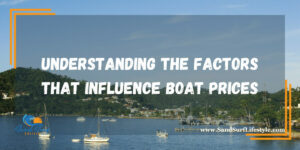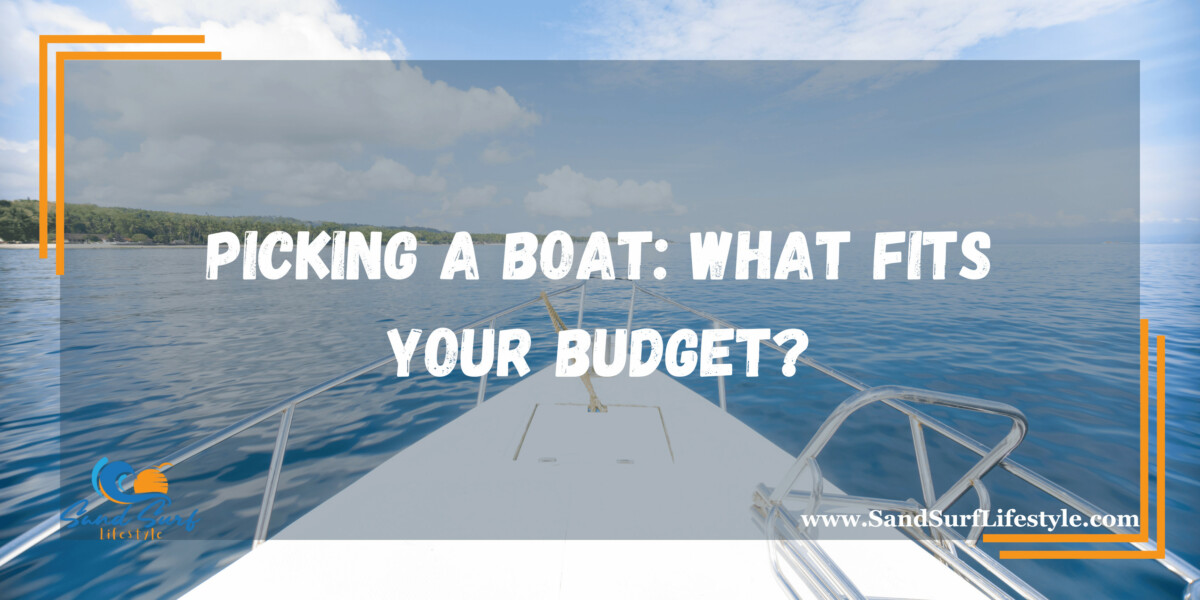When the allure of open water beckons, and the dream of owning a boat takes hold, one question invariably arises: “How much does a boat cost?” The answer, as you’ll soon discover, is as varied as the types of boats themselves. From sleek sailboats to powerful motor yachts and versatile fishing boats, the cost of boat ownership can span a wide range.
Understanding the Factors that Influence Boat Prices

1. Boat Type
The type of boat you choose is a paramount factor in determining its cost. The diversity within the boating world is astounding, ranging from modest inflatable dinghies to opulent luxury yachts that boast amenities comparable to upscale homes.
At the lower end of the price spectrum, you’ll discover small, versatile dinghies and personal watercraft designed for casual outings, fishing trips, or towing water skiers. These compact vessels are often priced affordably, typically starting around $1,000 to $15,000. Their simplicity and minimal features contribute to their cost-effectiveness, making them accessible to those new to boating or on a tight budget.
On the opposite end of the scale, luxury yachts redefine extravagance. These floating palaces can be equipped with opulent cabins, gourmet kitchens, and even helicopter landing pads. As such, their price tags rival high-end real estate, often reaching several million dollars. The cost of a luxury yacht isn’t merely an investment in a boat; it’s an investment in a luxurious, floating lifestyle.
2. Size Matters
The size of a boat is another crucial determinant of cost. Smaller boats, such as dinghies, rowboats, and personal watercraft like Jet Skis, are generally more budget-friendly. Their smaller dimensions make them accessible for novice boaters and those looking for a simple, no-fuss watercraft. These vessels can start at a few thousand dollars and extend up to around $15,000, depending on brand, features, and condition.
However, as boat size increases, so does the price tag. Medium-sized boats, like bowriders and runabouts, offer more space and versatility for water sports and leisurely outings. They typically range from $20,000 to $60,000, but this can vary significantly based on size and optional features.
For those with a penchant for the grandeur of the open seas, larger vessels beckon. Sailboats and motor yachts, especially those exceeding 40 feet in length, can command astronomical prices. These substantial vessels often require substantial investments, ranging from hundreds of thousands to several million dollars. Their spacious interiors, advanced navigation systems, and luxurious accommodations justify their high costs for those who can afford the nautical dream.
3. New vs. Used Boats
Choosing between a new or used boat is a significant cost-related decision. New boats come with several advantages, including the latest technology, warranties, and the assurance of pristine condition. However, these benefits come at a premium. New boat prices can be significantly higher compared to their used counterparts, as much as 20% to 30% or more.
Used boats, on the other hand, can offer substantial savings. These vessels have typically depreciated in value, allowing buyers to acquire a well-maintained boat at a fraction of the original cost. The savings can be particularly appealing, making it possible to access higher-end models or larger vessels that might be financially out of reach when buying new.
However, choosing a used boat requires due diligence. It’s essential to thoroughly inspect the boat’s condition, including the engine, hull, and interior components. Additionally, be prepared for potential maintenance costs that could arise from wear and tear over time. While used boats provide a more budget-friendly entry into boating, they may entail some trade-offs in terms of features and warranties.
To learn about boat price insights, check out this article.
Types of Boats and Their Price Ranges
1. Dinghies and Personal Watercraft (PWCs)
At the entry level of the boating spectrum, you’ll find inflatable dinghies and personal watercraft (PWCs) like Jet Skis. These compact and agile vessels offer an affordable gateway to recreational fun on the water. Dinghies, often used as tenders for larger boats, can be purchased for as low as $1,000 for basic models. They are perfect for short trips, fishing, or as a means of transportation between a larger vessel and shore.
Personal watercraft, such as Jet Skis, are equally accessible, with prices ranging from $5,000 for older models to $15,000 for newer, feature-rich versions. They are ideal for thrill-seekers who enjoy water sports and racing across the waves. While they may lack the amenities of larger boats, they provide an exhilarating aquatic experience at a budget-friendly price point.
2. Fishing Boats
For avid anglers, fishing boats come in various sizes and configurations to suit different needs. Smaller fishing boats, such as aluminum or fiberglass models, can start at around $10,000. These versatile vessels are designed for freshwater fishing in lakes and rivers, offering a cost-effective way to enjoy your favorite pastime.
On the other hand, specialized high-end fishing boats, particularly those built for deep-sea or offshore angling, can reach price tags exceeding $100,000. These boats are equipped with advanced navigation and fish-finding technology, spacious decks, and comfortable amenities to enhance the fishing experience. The investment in such vessels is often justified by the increased capabilities and comforts they provide to serious fishermen.
3. Bowriders and Runabouts
Bowrider boats, known for their versatility, are suitable for a wide range of water activities, from water skiing to leisurely cruises. Prices for bowriders typically fall in the $20,000 to $60,000 range, depending on factors like size and features. These boats feature an open bow area with seating, making them perfect for family outings and water sports.
Runabouts, a subtype of bowriders, often come with cabins or below-deck storage for added convenience. They offer a balance between affordability and functionality, making them popular choices for recreational boaters. Their price reflects the amenities and size, providing options for both budget-conscious buyers and those seeking more luxurious features.
4. Pontoon Boats
Pontoon boats are celebrated for their stability, spaciousness, and sociable layout. These versatile vessels are often favored for leisurely cruising and entertaining on the water. Basic pontoon boats start at around $15,000, making them an affordable choice for those seeking comfort and relaxation.
However, for those desiring the pinnacle of pontoon luxury, prices can exceed $100,000 or more. These high-end pontoons come equipped with plush seating, entertainment systems, wet bars, and even water slides, creating a floating oasis for gatherings and family outings. The wide price range ensures there’s a pontoon boat to match various budgets and preferences.
5. Sailboats
Sailboats offer a diverse array of options, from small day sailors to grand ocean-crossing vessels. Smaller sailboats, suitable for day trips and learning the ropes of sailing, can be acquired for as low as $10,000. These entry-level models often provide a cost-effective introduction to the world of sailing.
Conversely, larger and more sophisticated sailboats designed for long-distance cruising or racing can command prices well into the millions. These vessels come with advanced rigging, spacious cabins, and state-of-the-art navigation equipment, catering to seasoned sailors who seek the utmost in performance and comfort. The cost of sailboats, therefore, spans a broad spectrum, accommodating both beginners and seasoned mariners.
6. Cruisers and Motor Yachts
Cruisers and motor yachts represent the pinnacle of luxury on the water. Their prices reflect the opulence and amenities they offer. Smaller cruisers can start at around $100,000, providing a taste of luxury for those with a substantial budget. These vessels often feature comfortable cabins, entertainment areas, and advanced navigation systems.
However, for those who desire the epitome of nautical opulence, larger motor yachts can reach several million dollars or more. These extravagant vessels rival upscale homes in terms of accommodations, featuring multiple staterooms, gourmet kitchens, spacious decks, and even helipads. The price tag for such vessels is a reflection of the lavish lifestyle they promise, attracting buyers seeking the ultimate in luxury and comfort on the high seas.
New vs. Used Boats: Weighing the Pros and Cons
1. New Boats
Investing in a new boat can be an enticing prospect due to the numerous advantages it offers. New boats come with the latest technological advancements, ensuring you have access to cutting-edge features, from navigation systems to entertainment setups. They also typically include warranties, providing peace of mind in case of any manufacturing defects or issues. Moreover, the new boat is in pristine condition, free from wear and tear.
However, these advantages come at a premium price. New boats are generally more expensive than their used counterparts, often by a significant margin. Additionally, it’s crucial to consider depreciation. Like any other asset, the value of a new boat will decrease over time. While depreciation rates can vary depending on the make and model, it’s important to be aware that your new boat’s value may decrease, affecting its resale value in the future.
2. Used Boats
Used boats offer a compelling alternative, particularly for budget-conscious buyers. They can provide excellent value, with prices significantly lower than their new equivalents. The cost savings can be substantial, allowing you to access a wider range of boat types and models that may have been out of reach when purchasing new.
However, buying a used boat requires a meticulous approach. It’s essential to conduct thorough inspections to assess the boat’s condition, both structurally and mechanically. The boat’s maintenance history, hours of operation, and any prior repairs should be carefully examined. While used boats are generally more budget-friendly upfront, they may entail additional maintenance and repair costs over time. These ongoing expenses should be factored into your decision, as they can impact the total cost of ownership.
Hidden Costs of Boat Ownership
1. Maintenance and Repairs
Owning a boat entails regular maintenance to ensure it operates smoothly and safely. Routine tasks include cleaning to prevent the buildup of algae and barnacles on the hull, engine servicing to keep the powerplant in optimal condition, and hull maintenance to address any scratches or damage. Budgeting for these ongoing expenses is crucial, as they can add up over time. A common guideline is to allocate 10% to 15% of the boat’s initial purchase price annually for maintenance and repairs. However, this percentage can vary depending on factors like the boat’s age, size, and usage.
Neglecting maintenance can lead to more significant and costly repairs down the line, making proactive upkeep a wise investment in the long run. Properly cared-for boats not only maintain their value but also provide a safer and more enjoyable boating experience.
2. Mooring and Storage
Where you keep your boat when not in use can impact your overall costs. Mooring fees at marinas or storage costs at boatyards can vary widely based on location and boat size. Smaller boats may find affordable mooring options at public docks, while larger vessels often necessitate more substantial expenses, especially at high-demand marinas or during peak seasons.
Consider your geographic location and access to water bodies when budgeting for mooring or storage. Coastal areas and popular boating destinations may have higher fees. Additionally, the size and weight of your boat can influence costs, as larger vessels often require specialized lifting equipment and more significant dock space. It’s essential to include these expenses in your boat ownership budget to avoid unexpected financial burdens.
3. Insurance and Registration
Boat insurance is a vital component of responsible boat ownership. The cost of boat insurance varies depending on several factors, including the type of boat, its value, and your location. Factors like your boating experience, the intended use of the boat, and safety features onboard can also influence insurance premiums. While insurance is an added expense, it provides essential protection for your investment, covering potential damage, accidents, or liability claims.
Additionally, most regions require boat owners to register their vessels. Registration fees vary by jurisdiction but are typically based on boat size and type. Failing to register your boat or maintain proper insurance can result in legal consequences and financial liabilities, so it’s essential to budget for these expenses.
4. Fuel and Operating Costs
Fuel costs are a significant consideration, particularly for motorboats. The fuel efficiency of your boat will depend on factors such as engine type, size, and usage patterns. High-speed powerboats tend to consume more fuel, while sailboats are known for their lower fuel expenses.
Beyond fuel, there are other operating costs to factor in. Maintenance, such as engine servicing, cleaning supplies, and equipment upkeep, should be included in your budget. Additionally, consider the cost of the marina or launch fees, especially if you frequent locations that charge for access. Operating costs can vary widely based on your boating habits, so it’s essential to track your expenses and adjust your budget accordingly.
5. Accessories and Equipment
To enhance your boating experience, you may want to invest in various accessories and equipment. Navigational aids, safety gear like life jackets and fire extinguishers, and water toys for entertainment can quickly increase your expenses. The specific accessories you choose will depend on your boating preferences and activities.
While these items can improve your enjoyment of the water, it’s important to budget for them and prioritize purchases based on your needs. Consider starting with essential safety equipment and then gradually adding accessories as your budget allows. Properly equipping your boat ensures a safer and more enjoyable boating experience while managing costs effectively.
Choosing the Right Boat for Your Budget

1. Setting a Budget
Before embarking on the exciting journey of boat ownership, it’s essential to establish a well-defined budget. Beyond just considering the upfront purchase price, you must factor in the ongoing costs of maintaining and operating the boat. Be realistic about your financial capacity and what you can comfortably afford. This includes not only the initial payment but also maintenance, mooring, insurance, and fuel costs. Setting a comprehensive budget ensures that you make a purchase that aligns with your financial situation and avoids unforeseen financial stress down the line.
2. Consider Financing
For many prospective boat owners, financing can be an attractive option. Boat loans allow you to spread the cost of the boat over several years, making boat ownership more accessible. It’s crucial to explore various financing options and compare interest rates to understand how financing impacts your budget. Be sure to factor in monthly loan payments when determining your ongoing expenses, ensuring that they align with your financial goals and lifestyle.
3. Evaluate Your Needs and Lifestyle
Selecting the right boat involves a thoughtful evaluation of your specific needs and lifestyle. Consider how you intend to use the boat. If you’re primarily a weekend angler looking for fishing excursions, a small and affordable fishing boat might be sufficient. On the other hand, if you plan on embarking on extended cruises, hosting gatherings, or pursuing water sports, a more substantial and feature-rich vessel will be necessary. Your boat should cater to your intended activities and align with your lifestyle, ensuring that your investment enhances your enjoyment on the water.
To learn how to winterize your boat for long-term storage, check out this article.
Conclusion
In the world of boating, the question, “How much does a boat cost?” doesn’t have a one-size-fits-all answer. The cost of boat ownership varies widely, influenced by factors like boat type, size, and whether it’s new or used. It’s crucial to consider both the upfront purchase price and the ongoing costs of ownership, such as maintenance, mooring, and insurance. By carefully evaluating your budget and needs, you can navigate the waters of boat ownership with confidence, turning your aquatic dreams into a reality. Whether you’re setting sail on a modest dinghy or cruising the high seas on a luxurious yacht, the world of boating offers adventures, relaxation, and a connection to nature that’s truly priceless.
Please note that the contents of this blog are for informational and entertainment purposes only and should not be construed as legal advice. Any action taken based on the information provided in this blog is solely at your own risk. Additionally, all images used in this blog are generated under the CC0 license of Creative Commons, which means they are free to use for any purpose without attribution.

